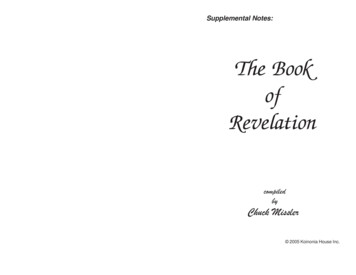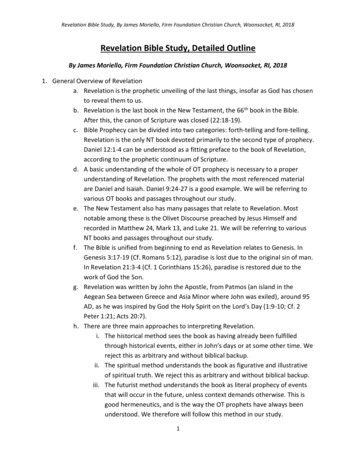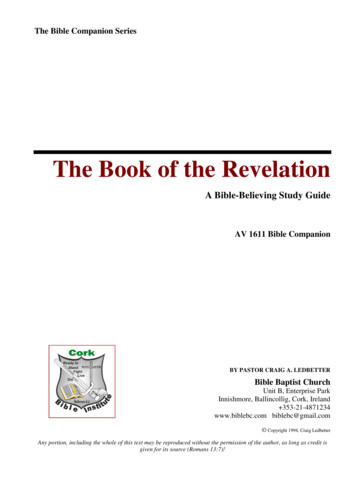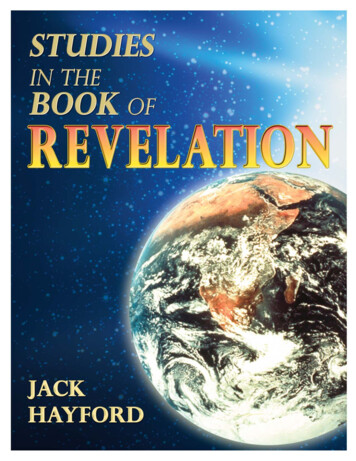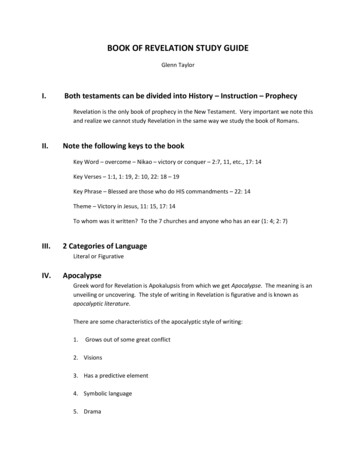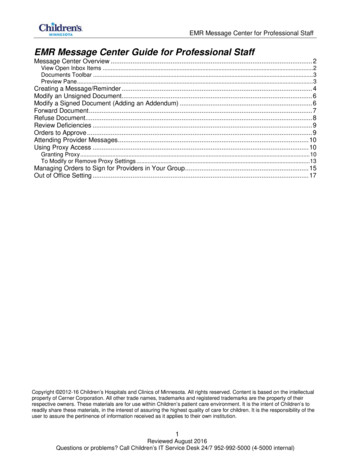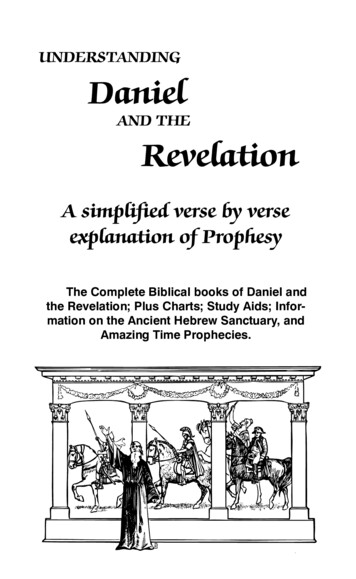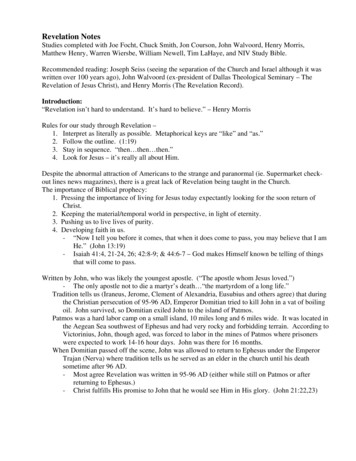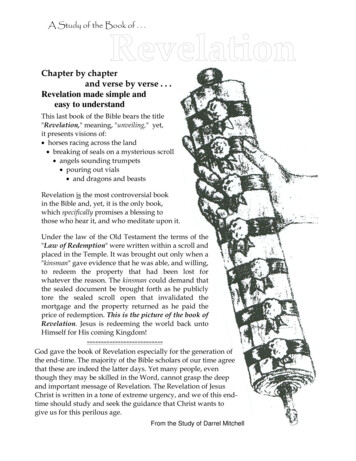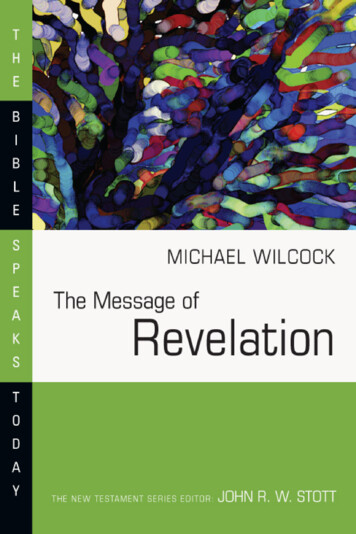
Transcription
The Message of RevelationI saw heaven openedMichael Wilcockformerly Vicar of St Nicholas’ Church, DurhamSeries editors:J. A. Motyer (OT)John Stott (NT)Derek Tidball (Bible Themes)www.ivpress.com/academic/
InterVarsity PressP.O. Box 1400Downers Grove, IL 60515-1426World Wide Web: www.ivpress.comE-mail: email@ivpress.com Michael Wilcock, 1975Study guide Inter-Varsity Press 1989All rights reserved. No part of this book may be reproduced in any form without written permission from InterVarsityPress.InterVarsity Press is the book-publishing division of InterVarsity Christian Fellowship/USA , a movement of studentsand faculty active on campus at hundreds of universities, colleges and schools of nursing in the United States of America,and a member movement of the International Fellowship of Evangelical Students. For information about local and regionalactivities, write Public Relations Dept. InterVarsity Christian Fellowship/USA, 6400 Schroeder Rd., P.O. Box 7895,Madison, WI 53707-7895, or visit the IVCF website at www.intervarsity.org.The Scripture quotations quoted herein are from the Holy Bible, New International Version . NIV . Copyright 1973,1978, 1984, 2011 by International Bible Society. Used by permission of Hodder and Stoughton Ltd. All rights reserved.“NIV” is a registered trademark of International Bible Society. UK trademark number 1448790. Distributed in NorthAmerica by permission of Zondervan Publishing House.ISBN 978-0-8308-9797-1 (digital)ISBN 978-0-87784-293-4 (print)
General prefaceTHE BIBLE SPEAKS TODAY describes three series of expositions, based on the books of the Old and New Testaments,and on Bible themes that run through the whole of Scripture. Each series is characterized by a threefold ideal:to expound the biblical text with accuracyto relate it to contemporary life, andto be readable.These books are, therefore, not ‘commentaries’, for the commentary seeks rather to elucidate the text than to apply it, andtends to be a work rather of reference than of literature. Nor, on the other hand, do they contain the kinds of ‘sermons’that attempt to be contemporary and readable without taking Scripture seriously enough. The contributors to The BibleSpeaks Today series are all united in their convictions that God still speaks through what he has spoken, and that nothing ismore necessary for the life, health and growth of Christians than that they should hear what the Spirit is saying to themthrough his ancient—yet ever modern—Word.ALEC MOTYERJOHN STOTTDEREK TIDBALLSeries editors
AcknowledgmentThe biblical text in this publication is from the Revised Standard Version New Testament, Second Edition copyright 1971, by the Division of Christian Education, National Council of the Churches of Christ in the United States of America,and used by permission.
PrefaceMost readers of the Bible have a love-hate relationship with the last of its sixty-six books. Revelation is full of mysteries, inthe modern sense of the word as well as in the special biblical sense of it, and like all mysteries they alternately repel andattract. Certainly friends in my own congregation at St Faith’s, Maidstone, have expressed both the exasperation of ‘Ican’t understand a word of it!’ and the curiosity of ‘Do let’s have a shot at it!’ This double reaction, together with anearlier study I had done on the subject of predictive prophecy, and the exhilarating memory of my own previous dips intoRevelation (further along the shore than the much-frequented chapters 2 and 3, though still only in the shallows), resultedin a series of Bible studies at our midweek church meeting.Whatever others may have gained from this series, the thing which impressed the one leading it was its inadequacy! Irealized afresh that even after those weeks of exploration, ‘depths all unfathomed lay beyond’. We had begun to wade,where till then most of us had merely paddled; but now I felt that the least one could do in face of such profundities was totry to learn to swim.This exposition is the result of such an attempt. It may be further removed from its spoken origins, more ‘bookish’, thansome of the other contributions to the twin series The Bible Speaks Today and The Voice of the Old Testament, for thesimple reason that it has to treat—though with no great pretensions to scholarship—problems which belong rather to thelecture room than to the pulpit. It has, on the other hand, tried to bring out a quality which shines on every page ofRevelation, and which belongs very much to the pulpit, because it should be a part of the living experience of the church.That is the appeal to the imagination. The truths of Revelation are indeed matters for the mind to grasp; but they arepresented to us in a riotous procession of symbols, with the panoply of music and colour and texture, and even taste andsmell. It is a great thing that one’s intellect should be captive to the Word of God. But in how many Christian people hasthe imagination never yet been harnessed for the service of Christ? That, I believe, is something which a renewedappreciation of John’s great vision can scarcely fail to achieve.MICHAEL WILCOCK
Chief AbbreviationsAGAVCairdFarrerA Greek-English Lexicon of the New Testament and Other Early Christian Literatureby William F. Arndt and F. Wilbur Gingrich (University of Chicago Press andCambridge University Press, 1957).The Authorized (King James’) Version of the Bible (1611).The Revelation of St John the Divine by G. B. Caird (A. and C. Black, 1966).The Revelation of St John the Divine by Austin Farrer (Oxford University Press, 1964).GlassonThe Revelation of John by T. F. Glasson (The Cambridge Bible Commentary on theNew English Bible, Cambridge University Press, 1965).JBThe Jerusalem Bible (Darton, Longman and Todd, 1966).JBPThe New Testament in Modern English by J. B. Phillips (Collins, 1958).KiddleThe Revelation of St John by Martin Kiddle (The Moffatt New Testament Commentary,Hodder and Stoughton, 1940).KnoxThe New Testament of our Lord and Saviour Jesus Christ translated by Ronald Knox(Burns, Oates and Wash-bourne, 1946).Maycock The Apocalypse by A. L. Maycock (Dacre Press, n.d.).MorrisThe Revelation of St John by Leon Morris (Tyndale New Testament Commentaries,Inter-Varsity Press, 1969).NEBRSVRVThe New English Bible (New Testament, 1961; Old Testament, 1970).The Revised Standard Version of the Bible (New Testament, 1946; Old Testament,1952; revised edition, 1971).The Revised Version of the Bible (1885).SweteThe Apocalypse of St John by H. B. Swete (Macmillan, third edition, 1911).Walvoord The Revelation of Jesus Christ by John F. Walvoord (Marshall, Morgan and Scott,1966).
The Structure of the DramaThe Prologue (1:1–8)The relevance of the book of Revelation1. The Title (1:1–3)2. The Greeting (1:4–8)Scene 1: The Church in the World: seven Letters dictated (1:9–3:22)The repeat of patterns1.2.3.4.5.6.7.8.Scene 1 opens: the church centred on Christ (1:9–20)The first Letter: to Ephesus (2:1–7)The second Letter: to Smyrna (2:8–11)The third Letter: to Pergamum (2:12–17)The fourth Letter: to Thyatira (2:18–29)The fifth Letter: to Sardis (3:1–6)The sixth Letter: to Philadelphia (3:7–13)The seventh Letter: to Laodicea (3:14–22)Scene 2: Suffering for the Church: seven Seals opened (4:1–8:1)The meaning of numbers1.2.3.4.5.6.7.8.9.Scene 2 opens: creation centred on Christ (4:1–5:14)The first Seal: conquest (6:1, 2)The second Seal: strife (6:3, 4)The third Seal: scarcity (6:5, 6)The fourth Seal: death (6:7, 8)The fifth Seal: the suffering of God’s witnesses (6:9–11)The sixth Seal: the final cataclysm (6:12–17)Yet the church is indestructible (7:1–17)The seventh Seal: ‘The rest is silence’ (8:1)Scene 3: Warning for the World: seven Trumpets sounded (8:2–11:18)The sequence of events1.2.3.4.5.6.7.8.9.10.11.Scene 3 opens: God hears his people’s cry (8:2–6)The first Trumpet: the earth stricken (8:7)The second Trumpet: the sea stricken (8:8, 9)The third Trumpet: the rivers stricken (8:10, 11)The fourth Trumpet: the sky stricken (8:12)Let the world of men beware the remaining Trumpets! (8:13)The fifth Trumpet: torment (9:1–12)The sixth Trumpet: destruction (9:13–21)The meaning of the last Trumpet (10:1–7)Yet the world is unrepentant (10:8–2:14)The seventh Trumpet: the world is no more (11:15–18)Scene 4: The Drama of History: seven Visions of cosmic conflict (11:19–15:4)The analysis of the drama1.2.3.4.5.6.7.8.9.10.11.Scene 4 opens: behind the veil, God’s covenant (11:19)The characters (12:1–6)The plot (12:7–16)The prelude (12:17)The first Vision: the beast from the sea (13:1–10)The second Vision: the beast from the earth (13:11–17)The number of the beast (13:18)The third Vision: the Lamb and his followers (14:1–5)The fourth Vision: the angels of grace, doom, and warning (14:6–13)The fifth Vision: the final reaping (14:14–20)The sixth Vision: a preview of Scene 5 (15:1)
12. The seventh Vision: the song of victory (15:2–4)Scene 5: Punishment for the World: seven Bowls poured out (15:5–16:21)The unity of the drama1.2.3.4.5.6.7.8.Scene 5 opens: behind the veil, God’s inescapable wrath (15:5–16:1)The first Bowl: the earth stricken (16:2)The second Bowl: the sea stricken (16:3)The third Bowl: the rivers stricken (16:4–7)The fourth Bowl: the sky stricken (16:8, 9)The fifth Bowl: torment (16:10, 11)The sixth Bowl: destruction (16:12–16)The seventh Bowl: the world is no more (16:17–21)Scene 6: Babylon the Whore: seven Words of justice (17:1–19:10)The identifying of symbols1.2.3.4.5.6.7.8.Scene 6 opens: the first Word about Babylon (17:1–6)The second Word: the mystery of Babylon (17:7–18)The third Word: the fall of Babylon (18:1–3)The fourth Word: the judgment of Babylon (18:4–20)The fifth Word: the death of Babylon (18:21–24)The sixth Word: the doom song of Babylon (19:1–5)The seventh Word: the successor of Babylon (19:6–8)These are true Words of God (19:9, 10)Scene 7: The Drama Behind History: seven Visions of ultimate reality (19:11–21:8)The millennium1.2.3.4.5.6.7.Scene 7 opens: the first Vision: the Captain of the armies of heaven (19:11–16)The second Vision: his victory is sure (19:17, 18)The third Vision: his enemies are doomed (19:19–21)The fourth Vision: the devil (20:1–3)The fifth Vision: the church (20:4–10)The sixth Vision: the last judgment (20:11–15)The seventh Vision: the new age (21:1–8)Scene 8: Jerusalem the Bride: seven final Revelations (21:9–22:19)1.2.3.4.5.6.7.8.Scene 8 opens (21:9)The first Revelation: God’s city (21:10–21)The second Revelation: God’s dwelling (21:22–27)The third Revelation: God’s world renewed (22:1–5)The fourth Revelation: God’s word validated (22:6–10)The fifth Revelation: God’s work completed (22:11–15)The sixth Revelation: God’s final blessing (22:16, 17)The seventh Revelation: God’s final curse (22:18, 19)The Epilogue (22:20, 21)The book we could do withoutThe Author’s last word (22:20, 21)
IntroductionThe books in the present series are intended to be ‘expositions’ of Scripture. The danger of attempting to write somethingof this kind, neither a commentary nor a volume of sermons, is of course that one may fall between two stools andproduce a book which is negative and unsatisfying. But so far as the Revelation to John is concerned, there is certainlyroom for positive exposition which takes a course between the academic and the sermonic, and tries to combine exegesis(what the text says) with application (what it says to us). For the literature on Revelation is in one respect unique. No partof the Bible has had written about it so many commentaries—indeed ‘a great multitude which no man could number’—and so few books which the ordinary Christian of average intelligence can actually sit down and read, to find John’smessage grappled with and applied to his present needs.This volume attempts to be one of the latter. Whether it succeeds or not is for the reader to say. The writer has toconfess that he often found himself wondering if he had bitten off more than he could chew, let alone digest! The sheerlength and difficulty of Revelation, compared with other parts of the Scripture being expounded in this series, bringspecial problems. Its twenty-two chapters will have to be treated more sketchily than would be the case with the shorterLetters of the New Testament, if the length of the exposition is to be kept within bounds, and that means that one willinevitably do less than justice to some of their riddles. The difficulty of the book means that the balance betweenexplanation and application has to be weighted on the side of the former, so that there is a higher proportion of exegesisthan with other books: the bones will tend to show more. However, although the reader may not find every wordinterpreted, it is hoped that he will become sufficiently conversant with the language to be able to catch the drift of theargument; and although there has to be a good deal of explanation, this has been concentrated in the short ‘essays’ at thebeginning of each Scene of the drama, so that it does not clutter the text itself too much.The analysis of the book as a drama in eight Scenes is an example of this. It is an important matter, because some of theunnecessary difficulties of Revelation arise from the traditional divisions into chapters and verses, which are useful butoften misleading. A clear analysis of John’s visions, arrived at by an attempt to put oneself in his place and see things ashe saw them, is a great aid to understanding what he is about. The reasons for the one adopted here are gathered togetherin the introductory essay to Scene 4 (pp. 110–115).Another valuable aid—indeed the most valuable—is Scripture itself. Of the sixty-six books, perhaps Revelation aboveall is dependent on the rest for its proper interpretation. Hence Glasson’s judicious observation: ‘The marginal referencesin the Revised Version of the Bible are often as enlightening as any commentary.’ 1 The importance of this basic toolis referred to again in connection with the Prologue (p. 30). Indeed, all that follows is written in the conviction that thereal, central, message of Revelation can be understood without the help of any ‘background knowledge’ drawn frombeyond the limits of the Bible itself.Nevertheless, certain questions inevitably arise concerning the book’s background, and even if they are not consideredessential to a grasp of its main message, they deserve at least a brief treatment here.The style of the book‘Revelation’ and its alternative title ‘Apocalypse’ come from the Latin and Greek words for ‘unveiling’. The latter gaveits name to a whole class of Jewish religious writings which appeared chiefly between 200 BC and AD 100, and which isknown as ‘apocalyptic literature’ or simply ‘apocalyptic’. It is generally agreed that the Bible contains examples of this,particularly in the books of Daniel and Revelation.A comparison between Revelation and non-biblical books of this type does indeed show many similarities. Truths whichcould not be discovered by normal investigation (matters of the future, for example, or of the spiritual realm) areunveiled, usually through the agency of angels, in lurid colours and with a wealth of bizarre symbolism—stars andmountains, monsters and demons, and complex number schemes.This sort of thing is obvious enough in John’s book. But there are other features notable by their absence. Where theapocalyptists often attached their ‘visions’ to some famous name of a past age, as if it were Enoch or Ezra describingwhat he had seen, Revelation claims to be by ‘John’, which even if a pseudonym is still not one in the apocalyptic style. Italso claims to be a ‘prophecy’ (1:3), and expects the activity of God and the moral response of man to be a part ofpresent-day life, as the old prophets (unlike the apocalyptists) did.Yet at a deeper level there are important similarities. The soil which nourished ‘Enoch’ and ‘Ezra’ and the rest was aJewish community very conscious of its precarious position in a world of big, unfriendly powers. Its voice was the voiceof the oppressed minority, vainly protesting its rightness and comforting itself with the prospect of eventual vindication.The apocalyptists, like John, saw everything in stark contrasts of black and white. They were at once extreme pessimists,for whom things were so bad that only God could ever put them right, and extreme optimists, looking forward to the timewhen he was going to do just that.This attitude, along with much of the conventional style of apocalyptic writing, was John’s when he wrote Revelation.‘The God of the spirits of the prophets’ brought together the man and the method, and the result was a work designed (inthis case with divine effectiveness) to remind another oppressed minority, the Christian church, how things really stand inthe spiritual realm. 2The circumstances of the book
To the Christian churches in seven of the towns of Asia Minor Revelation was sent as a circular letter, to be read aloud intheir meetings as a message directed to the real needs of real first-century people. The churches had been establishedlong enough to display between them a full range of spiritual conditions, from tenacious devotion to decadent laxity. Themessage was consequently twofold. It brought encouragement, in the true apocalyptic manner, to Christians who wereunder great pressure, assuring them that their enemies would in the end be destroyed and God would be triumphant. Onthe other hand, in the style not of apocalyptic but of prophecy, it challenged them to combat even within themselves thesubtle forces of evil, for Satan must be overcome and Christ given his rightful place here and now in their own spiritualand moral lives.The Roman Empire, powerful in many senses, exercised one particular power which became a cause of great trials tothe early Christians. The growing practice of ‘emperor worship’ meant that an increasing number of them were requiredpublicly to make the fateful choice between Caesar and Christ. Every age has its equivalent test of a Christian’s trueallegiance; for them it meant actual persecution and the threat of martyrdom.In this respect the situation in the churches of Revelation is a pointer to the date of the book: it must have been lateenough for them to be well established, but early enough for them to have felt only the first squalls of the storm ofpersecution which was in due course to burst upon them.Some scholars combine these factors with calculations based on the statements of 13:18 or 17:10, to place the writing ofthe book at the end of Nero’s reign (AD 54–68), or, less convincingly, in Vespasian’s (AD 69–79). Most evidence,however, seems to favour a date in the latter part of the reign of Domitian (AD 81–96). 3This would mean that if the traditional view of authorship is correct, and the book was written by the apostle John, hewould have been in his eighties when the vision of Patmos was given him. There is nothing intrinsically unlikely in that;another great visionary, Moses, had his first dazzling sight of God’s glory at the age of eighty (Acts 7:23, 24). But thereare other reasons why doubt has been cast on the apostolic authorship. The arguments turn on the relationship between thefive books attributed to John (the Gospel, three Letters, and the Revelation), and the possible existence of a second, andeven a third, person of the same name. Guthrie concludes fifteen pages of discussion on the subject with these words: ‘Toextract a conclusive or even satisfactory result from all this mass of conjecture seems impossible. The most certain line ofevidence is the early tradition At least, if this is the true solution it at once explains the rise of the tradition, which noneof the others satisfactorily does. But many prefer to leave the authorship an open question.’ 4 At all events, the ‘John’ ofRevelation makes the clear apostolic claim that though he may have written the book, its real author is none other thanJesus Christ. ‘No book in the Scriptures opens in such solemn terms; none makes so uncompromising a statement of its owndirect inspiration.’ 5The interpretation of the bookBut what—and this is the most important question—what does it all mean? The innumerable attempts to explain it may beclassified in various ways. Opinions about its structure are legion: so far as that is concerned, Luther’s comment has a wryaccuracy—that ‘everyone thinks of the book whatever his spirit imparts’. 6 Opinions about its historical references arebroadly of four kinds: the preterist view, that it describes in veiled language events of John’s own time, and nothing more;the futurist, that it is largely a prophecy of events still to come; the historicist, that it is a chart of the whole of history fromChrist’s first coming to his second, and beyond; and the idealist, that between messages for the first century andprophecies of the far future it deals chiefly with principles which are always valid in Christian experience. Opinions alsodivide over the particular matter of the ‘millennium’, the thousand-year period described in chapter 20; premillennialism,postmillennialism, and amillennialism will be considered in the introductory essay to Scene 7 (pp. 175–182).It is impossible for a commentator to avoid plumping for one or another of these views, unless he waters his commentsdown to the point where they cease to be nourishing. This exposition accordingly opts for a particular kind ofinterpretation, as will quickly become apparent to the connoisseur who has a nose for such things; and it does so not frompreconceived ideas, but because a straightforward reading of the text seems to point that way. It does try to avoid,however, the exasperating use of the adverbs ‘clearly’ and ‘obviously’ in statements which those with other views mightthink not at all clear or obvious!The use of the bookThe conviction that Revelation really is meant to reveal truth, and not to obscure it, and that its treasures really do lie onthe surface if one looks for them in the right light, is by no means the same as a belief that its meaning will be spelt out forus verbally, with logic and precision. Of course God does not despise verbal communication; after all, ‘the Word’ was thename he gave to his own Son. But his words, his declarations and arguments and reasonings, have all been spoken by thetime he brings John to Patmos. What he has in store for his last unveiling is a word of a different sort: an acted word, aword dramatized, painted, set to music—a word you can see and feel and taste. In fact, it is a sacrament.It is no use reading Revelation as though it were a Paul-type theological treatise in a slightly different idiom, or a Lukestyle history projected into the future. You might as well analyse the rainbow—or the wine of communion or the water ofbaptism. Logical analysis is not what they are for. They are meant to be used and enjoyed.We of the late twentieth century, we of all people, should understand this. We live in a post-literate age, which, tiring ofwords, is beginning to talk again in pictures. So television replaces radio, and the noun ‘image’ comes back into use with adozen modern connotations. Well, God knew all about it long ago; and when his children have had enough of reciting
systematic theology, he gives them a gorgeous picture-book to look at, which is in a different way just as educational.Pictures, potent images of Christian truth, to use as we use the sacraments—that is what we are given in Revelation. Doyou remember the spell ‘for the refreshment of the spirit’ which Lucy Pevensie found in the Book of Magic? When thebook was closed, the spell (which was a story) began to fade from her mind, until all she could remember was that ‘it wasabout a cup and a sword and a tree and a green hill’. 7 It is the images that stick. John’s pages are studded with them, forthe same purpose: that our imagination, as well as our mind, should grasp the key concepts of the faith. So till thebridegroom returns—till the city descends from the sky, and the day of the wedding-feast dawns—we do this, inremembrance of him.
The Prologue(1:1–8)
The Relevance of the book of RevelationCome up hither’, says the mysterious voice (Rev. 4:1); and John is transported into regions so strange and remote thatmany Christians hesitate to explore them with him. The Gospels and Letters are territory which is more familiar and moreaccessible; can this extraordinary book at the end of the Bible, belonging (in more senses than one) to a different world,have anything to do with the practicalities of life in the twentieth century?From the outset, however, the book of Revelation claims to have been written not for the benefit of a minority in thechurch, but for all; and not for its own age alone, but for the church in all ages. Like the rest of the Bible, it speaks today.a. Relevance claimed in the TitleLuke’s two-volume history (his Gospel, and the book of Acts) was compiled for a person whom he calls Theophilus (Lk.1:3, Acts 1:1). Nevertheless we have no doubt that what he wrote for Theophilus is relevant for readers in any age. Paul’sLetters were written to particular Christians living in the Roman Empire. Nevertheless we take it that what he wrote tothem applies equally to us. These writings were meant specifically for first-century readers, but we do not hesitate toaccept them as relevant to modern Christians also. How much more ought we to accept the relevance of those parts of theNew Testament which are actually addressed to Christian people in general?And the Title (1:1–3) tells us that this book is of such a kind. It is the Revelation of Jesus Christ given by God to hisservants. If I am one of those who serve him, then this book is for me, however irrelevant its contents may seem when Ifirst glance through it. It behoves me therefore to persevere in reading it, so that I may receive the blessing its authorpromises me (1:3).b. Relevance claimed in the GreetingAlthough in the Title John tells us that his message is for Christ’s servants in general, in the Greeting (1:14–8) he says he iswriting in particular to the seven churches of Asia. What he sends them is more than the short letters contained in chapters2 and 3. The entire book is his letter, and his final ‘yours sincerely’ comes in its very last verse (22:21). So the address inthe Title (‘to his [Christ’s] servants’) and that in the Greeting (‘to the seven churches that are in Asia’) are both headingsto Revelation as a whole. What John is writing is in form a letter to a group of first-century Christians, but in fact amessage to all Christians without distinction. Its beginning and ending place it in the same category as the Letters of Peterand Paul, of James and Jude, written in the first instance to situations in the early church, yet containing apostolic truthintended by God for the church in all ages. Revelation is no mere appendix to the collection of letters which makes up thebulk of the New Testament. It is in fact the last and grandest of those letters. As comprehensive as Romans, as lofty asEphesians, as practical as James or Philemon, this ‘Letter to the Asians’ is as relevant to the modern world as any of them.c. Relevance claimed in the opening SceneWe leave the Prologue (1:1–8), and steal a preview of Scene 1 of the great drama, where we see the risen Christ dictatingto John his letters to the seven churches. To the church in Pergamum he says: ‘I have a few things against you: you havesome there who hold the teaching of Balaam’ (2:14). To the church in Thyatira he says: ‘I have this against you, that youtolerate the woman Jezebel’ (2:20). What do we learn from these references?It was in the time of Moses, probably in the thirteenth century BC, that Balaam misled God’s people by his falseteaching. Thirteen hundred years later, however, that teaching is still very much alive, misleading God’s people atPergamum. It was in the ninth century BC that Jezebel, Ahab’s queen, was causing similar trouble in Israel. But 900 yearslater, in Thyatira, we find not merely her teaching but the lady herself once more in evidence!Christ is not of course speaking of the reincarnation of a person, but of the repetition of a pattern. Bible history is full ofsuch repetitions. Thus the preaching of Jesus repeats the pattern of the preaching of Jonah (Mt. 12:39 ff.), and the liftingup of Jesus on the cross is like the lifting up of the bronze snake by Moses (Jn. 3:14). John the Baptist not only resembles,but in a sense actually is, the prophet Elijah, who lived centuries earlier (Mt. 11:14).The Letter to the Hebrews, rooted as it is in the Old Testament, provides many examples. God’s message coming withurgency through the mouth of David, ‘Today hear his voice’, was an equally urgent message when the HebrewChristians read it 1,000 years after David, and when Moses’ contemporaries heard it 300 years before him (Heb. 3:7–4:10). Going back further still, the oath God made to Abraham has undiminished force for us (Heb. 6:13–18). And it wasin the remotest past of human history that Abel expressed his faith by the sacrifice he offered to God, but even now ‘hebeing dead yet speaketh’ (Heb. 11:4, AV). Just as in every generation the evil influence of Balaam and Jezebel is likely toreappear, so God in his mercy is constantly repeating the great truths of salvation; they are ‘new every morning’ (La.3:23).So we must give the fullest meaning to the present tenses of these verbs. The immediacy of Hebrews 3:7, which may betranslated ‘the Holy Spirit is saying “Today hear his voice” ’, is matched by that of the seven-times-repeated commandof Revelation 2 and 3, which we could similarly translate, ‘Hear what the Spirit is saying to the churches.’ What we havehere is a restatement of those truths of the spiritual world which were as real in the days of John as they had been in thedays of Jezebel, and which are no less relevant today
Chief Abbreviations AG A Greek-English Lexicon of the New Testament and Other Early Christian Literature by William F. Arndt and F. Wilbur Gingrich (University of Chicago Press and Cambridge University Press, 1957). AV The Authorized (King James’) Version of the Bible (1611). Caird The Revelation of S
